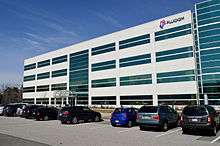Fluidigm
Fluidigm Corporation is a public, American company engaged in the design, manufacture and sale of biological research equipment based on integrated fluidic circuit technology.[1] In 2009, Fluidigm was described as "the world's leading manufacturer of microfluidic devices."[2] Among the applications to which Fluidigm products are put to use are protein crystallization, genotyping, DNA analysis and PCR.[3]
Formerly | Mycometrix |
|---|---|
| Public (2011– ) | |
| Traded as | NASDAQ: FLDM Russell 2000 Component |
| Founded | 1999 |
| Headquarters | , United States |
Key people | S. Christopher Linthwaite (President, CEO) |
| Revenue | |
Number of employees | 500 (2014) |
| Website | Official website |

Business model
Fluidigm's products leverage the capabilities of multilayer soft lithography to create microfluidic devices:[4] specifically, technology developed by one of the co-founders and branded "Integrated Fluidic Circuitry".[5]
Fluidigm is a public company traded on the NASDAQ stock exchange under the ticker symbol FLDM.[6]
Fluidigm has a number of academic partners whose engagement is aimed to provide a wow factor to exemplar product uses; partners include Wellcome Trust Sanger Institute, the Broad Institute, the Genome Institute of Singapore and Kyoto University.[1]
Among companies which include "integrated microfluidic technology" into their products, the only competitor which a market focus on biotechnology as of 2011 appeared to be RainDance Technologies.[3]
Going into 2015, the company is making an effort to infuse industrial design, aesthetic and customer centricity principles to help distinguish their products from those of competitors and generate a distinctive brand experience for users.[1]
History
Fluidigm was founded in 1999 as "Mycometrix" by Steve Quake and Gajus Worthington.[6][5] The company was formed to commercialize technology developed by Quake at the California Institute of Technology referred to as microfluidic large-scale integration and "branded" under the name Integrated Fluidic Circuits.[5] As of 2015, Worthington remains with the company as president and chief executive officer (CEO),[1] while Quake was a member of the company's scientific advisory board as of 2011.[5]
The company completed a successful initial public offering (IPO) in February 2011, raising about US$75,000,000.[6][7] This followed a failed, ill-timed IPO in 2008.[6] As of the 2011 IPO, Fluidigm had not yet become profitable, but had accumulated nearly US$200,000,000 in debt.[6]
Operations
At the end of 2014, Fluidigm had a headcount of 500 personnel.[1]
In addition to its headquarters and laboratory facility in South San Francisco, California, which it expanded in 2014,[8] the company in 2005 established the first biochip manufacturing facility in Singapore.[2][5] The Singapore facility was in 2009 led by Grace Yow, who also held the position of Fluidigm vice president of worldwide manufacturing.[2]
Products
Fluidigm's products typically consist of single-use biochips, instrumentation for handling biochips and software for instrument operation and data collection and analysis.[2] No Fluidigm products had been approved for clinical use in the United States as of 2009.[2]
Fluidigm's first commercial product was aimed at the protein crystallization market and was launched in 2003 under the brand "Topaz".[5] The company's second marketed product targeted high-throughput DNA amplification and was launched in 2006 under the brand "BioMark".[5] By 2013, BioMark had been adapted to real-time PCR and was capable of running >9000 reactions in parallel.[9] A high-throughput genotyping system, FLUIDIGM EPI, was introduced in 2008.[5]
The C1 Single-Cell Auto Prep, or C1 system, was released in the early 2000s aimed at delivering 96 single-cell capture and processing events in parallel.[1] One aim of development forward from the C1 system is increasing parallel throughput.[1] This initial line of instruments purportedly cost about US$200,000 apiece to purchase in 2011.[6] One reported use for the instruments is "to identify signatures of induced pluripotent stem cells".[6]
In June 2015, Fluidigm introduced Helios™, the third-generation CyTOF® platform that enables system-level biology at single-cell resolution, on an accessible, expandable system designed for clinical trials. CyTOF technology provides a high-resolution proteomic profile of each cell, which distinguishes it from all other cells and reveals the heterogeneity of the sample. Fluidigm also announced proteomics sample barcoding, which enables Helios and all other CyTOF customers to take advantage of multiplexing in their experimental design. [10]
Notes
- Dutton 2015.
- Nanotechnology Business Journal editors 2009.
- Angelescu 2011, p. 226.
- Angelescu 2011, p. 227.
- Angelescu 2011, p. 225.
- Timmerman 2011.
- Tse 2011.
- GenomeWeb staff reporter 2014.
- Yan 2013, p. 72.
- Bonislawski, Adam (July 2, 2015). "Fluidigm Aims to Expand CyTOF Market with Launch of New Platform, Barcoding System". GenomeWeb. Retrieved July 2, 2015.
References
- Angelescu, Dan E. (2011). "5.3.1 Microfluidic Large-Scale Integration: Fludigm". Highly Integrated Microfluidics Design. Integrated Microsystems. Artech House. ISBN 9781596939806 – via Google Books.CS1 maint: ref=harv (link) Note: the book version viewed did not include the entire chapter cited here, only pages 225, 226 and 227.
- Dutton, Gail (15 Jan 2015). "Fluidigm Pioneers Single-Cell Biology". Corporate Profile. Genetic Engineering & Biotechnology News. 34 (2). pp. 8–9.CS1 maint: ref=harv (link)

- GenomeWeb staff reporter (19 Sep 2014). "PerkinElmer; Guardant Health; PacBio; BGI Tech; Thermo Fisher, UCSD; Fluidigm; Cynvenio; and More". In Brief This Week. GenomeWeb. New York, NY.CS1 maint: ref=harv (link)

- Nanotechnology Business Journal editors (7 Sep 2009). "Fluidigm: 250 Million Microfluidic Valves Manufactured -- and Counting". Nanotechnology Business Journal. NewsRx, LLC. Archived from the original on 2 April 2015 – via HighBeam Research.CS1 maint: ref=harv (link)
- Timmerman, Luke (11 Feb 2011). "Fluidigm Raises $75M in Second Chance at IPO". San Francisco. Xconomy.CS1 maint: ref=harv (link)
- Tse, Andrea (10 Feb 2011). "Fluidigm Pops After IPO". The Street.CS1 maint: ref=harv (link)
- Yan, Hong; Kun, Liu Xiao (13 Jun 2013). "5. Real-Time Fluorescent PCR by Labeled Primer with a Single Fluorescent Molecule". In Nolan, Tania; Bustin, Stephen A. (eds.). PCR Technology: Current Innovations (3rd ed.). CRC Press. ISBN 9781439848050 – via Google Books.CS1 maint: ref=harv (link)
External links
| Wikimedia Commons has media related to Fluidigm. |